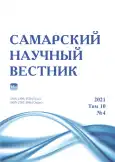Botanical-geographical differentiation and succession systems on the territory of the Republic of Bashkortostan
- Authors: Gorichev Y.P.1
-
Affiliations:
- South Ural State Nature Reserve
- Issue: Vol 10, No 4 (2021)
- Pages: 24-28
- Section: General Biology
- URL: https://journals.rcsi.science/2309-4370/article/view/104890
- DOI: https://doi.org/10.17816/snv2021104103
- ID: 104890
Cite item
Full Text
Abstract
On the territory of the Republic of Bashkortostan the main regularities of landscape differentiation are manifested – latitudinal zoning, altitudinal zoning and the barrier effect, which determine the territorial differentiation of the vegetation cover. The existing schemes of botanical-geographical and geobotanical zoning reflect these patterns. The largest zoning units are zonal structures (forest, forest-steppe and steppe regions), within which, on the basis of geological and geomorphological features, smaller taxonomic units are distinguished – provinces, areas, districts. The zoning method proposed by S.M. Razumovsky which is based on the concept of a succession system is of interest. According to this concept, the vegetation cover of the Earth is divided between succession systems. The boundaries of successional systems are outlined by the boundaries of the geographical areas of key species – edificators of indigenous forest phytocenoses. S.M. Razumovsky presented a scheme of botanical-geographical zoning, made on a small scale. The boundaries of succession systems, with the exception of some areas, are not delineated. The author set a goal: to determine a list of succession systems common on the territory of the Republic of Bashkortostan, to outline their boundaries and give their brief characteristics. As a result of literary sources study and analysis, the author has come to the conclusion that 4 succession systems are widespread on the territory of the Republic of Bashkortostan: 1) broad-leaved-dark coniferous forests with climax species of Siberian spruce, Siberian fir, pedunculate oak, heart-leaved linden and Norway maple; 2) dark coniferous forests, with climax species of Siberian spruce and Siberian fir; 3) broad-leaved forests with climax species of pedunculate oak, heart-leaved linden and Norway maple; 4) light coniferous forests with sub-climax species of Scots pine and Sukachev larch.
Full Text
##article.viewOnOriginalSite##About the authors
Yuriy Petrovich Gorichev
South Ural State Nature Reserve
Author for correspondence.
Email: gorichev-1997@mail.ru
candidate of biological sciences, deputy director
Russian Federation, Revet village, Beloretsky District, Republic of BashkortostanReferences
- Физико-географическое районирование Башкирской АССР // Ученые записки Башкирского государственного университета. Серия географическая. 1964. Т. XVI, № 1. 208 с.
- Кадильников И.П., Тайчинов С.Н. Условия почвообразования на территории Башкирии и его провинциальные черты // Почвы Башкирии. Уфа, 1973. С. 15–62.
- Крашенинников И.М., Кучеровская-Рожанец С.Е. Растительность Башкирской АССР // Природные ресурсы Башкирской АССР. Т. 1. М; Л.: Издательство АН СССР, 1941. 154 с.
- Жудова П.П. Геоботаническое районирование Башкирской АССР. Уфа: Башкнигоиздат, 1966. 124 с.
- Горчаковский П.Л. Растительность и ботанико-географическое деление Башкирской АССР // Определитель высших растений Башкирской АССР. М.: Издательство «Наука», 1988. С. 3–13.
- Разумовский С.М. Закономерности динамики биоценозов. М.: Наука, 1981. 231 с.
- Разумовский С.М. Перечень единиц ботанико-географического районирования // С.М. Разумовский. Избранные труды. М.: КМК. 1999. С. 195–236.
- Васильев Я.Я. Естественно-исторический очерк лесов северной части Зилаирского кантона Башкирской республики // Лесоведение и лесоводство. 1929. Вып. 7. С. 101–137.
- Новопокровский И.В. Материалы для познания растительности Южного Предуралья. Стерлитамакский и Уфимский кантоны. М.–Л.: Сельхозгиз, 1931. 143 с.
- Письмеров А.В. Лесная растительность Уфимского плато // Горные леса Южного Урала. Уфа: Башкирское книжное издательство, 1971. С. 109–117.
- Горчаковский П.Л. Широколиственные леса и их место в растительном покрове Южного Урала. М.: Наука, 1972. 146 с.
- Курнаев С.Ф. Теневые широколиственные леса Русской равнины и Урала. М.: Наука, 1980. 312 с.
- Попов Г.В. Леса Башкирии. Уфа: Башкирское книжное издательство, 1980. 144 с.
- Попов Г.В. Особенности распространения древесных пород на Уфимском плато // Возобновительные процессы в горных широколиственно-хвойных лесах. Уфа, 1981. С. 41–51.
- Мартьянов Н.А., Баталов А.А., Кулагин А.Ю. Широколиственно-хвойные леса Уфимского плато: фитоценотическая характеристика и возобновление. Уфа: Гилем, 2002. 222 с.
- Горчаковский П.Л. Растения европейских широколиственных лесов на восточном пределе их ареала // Труды ин-та экологии растений и животных Уральского филиала АН СССР. Вып. 59. Свердловск, 1968. 207 с.
- Горичев Ю.П., Давыдычев А.Н., Алибаев Ф.Х., Кулагин А.Ю. Широколиственно-темнохвойные леса Южного Урала: пространственная дифференциация, фитоценотические особенности и естественное возобновление. Уфа: Гилем, 2012. 176 с.
- Горчаковский П.Л. Высокогорная растительность Яман-Тау – крупнейшей вершины Южного Урала // Ботанический журнал. 1954. Т. 39, № 6. С. 827–841.
- Чибилёв А.А. Природное наследие Оренбургской области. Оренбург: Оренбургское кн. издательство, 1996. 384 с.
- Фильрозе Е.М., Рябчинский А.Е., Гладушко Г.М., Конашов А.В. Экология лесов Западной Башкирии. Свердловск: УрО АН СССР, 1990. 180 с.
Supplementary files







